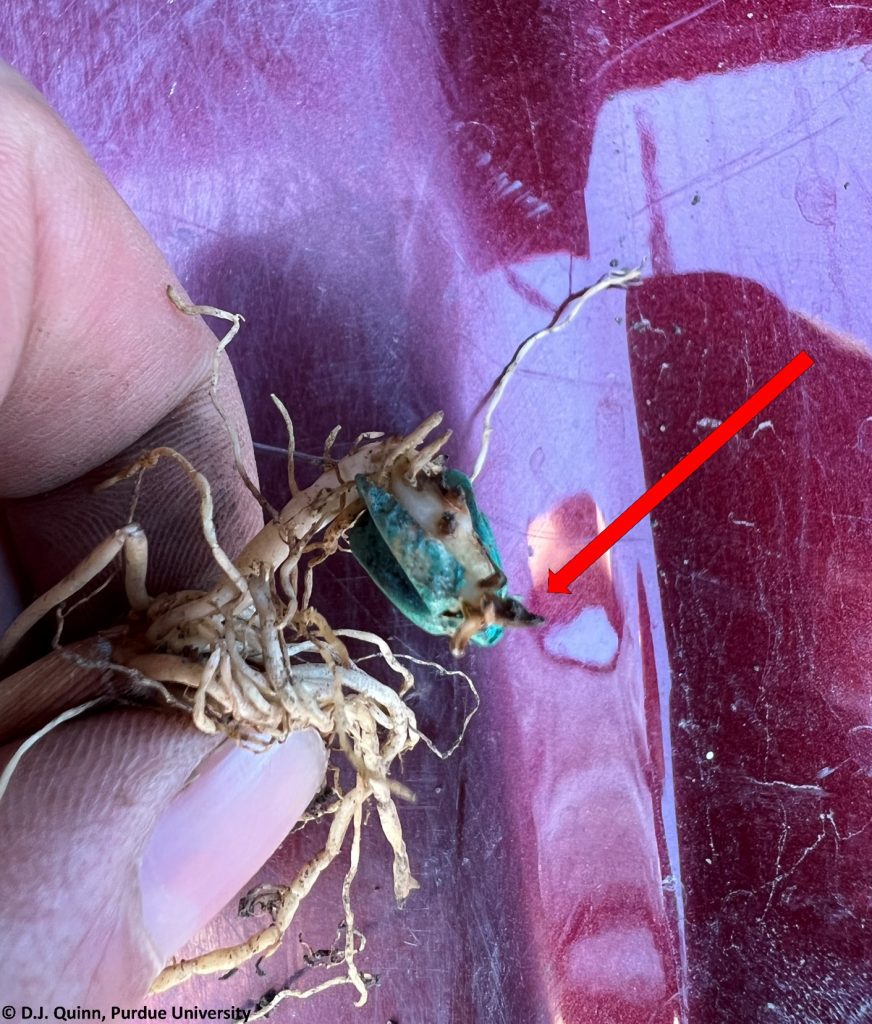When emerging corn plants look unhealthy try checking the roots
By Dan Quinn, Ph.D.
Assistant Professor of Agronomy, Purdue University
As young corn plants begin to emerge and grow this spring, you may find yourself asking why does my (or the neighbors) corn look stunted, pale green – or for a lack of better words – “crappy?” Well, one of the first places to look for the why is to dig up some plants and look below ground at the roots.
Many early season issues where corn plants get off to a poor start can be pinpointed to what is going on with the root system, and it is also the area of the plant that is often overlooked. Therefore, just because corn plants were planted into good conditions resulting in rapid and uniform emergence, does not mean that successful stand establishment has been achieved.
Successful stand establishment of corn is largely driven by the successful initiation and transition of corn plant reliance on the seminal root system to the nodal root system. A corn plant can be identified as having two separate root systems, often referred to as the seminal and nodal root systems.

The seminal root system is comprised of the radicle (first root to emerge) and lateral seminal roots (Figure 1). This is the primary root system of the corn plant up until approximately growth stage V3 (three corn leaves present with visible collars). The seminal root system is used to anchor the young corn plant and help with some water and nutrient uptake. However, a young corn seedling primarily depends on the energy and nutrition reserves within the corn seed for development.
Therefore, since young corn plants depend on seed reserves until the establishment of and transition to the nodal root system, damage to the seminal roots, corn seed or mesocotyl (white tissue connecting the seed to the coleoptile base) can result in severe plant stunting or even death. Injury examples include salt damage due to high starter fertilizer rates (Figure 2), seedling disease and insect feeding.
At the V3 growth stage, the corn plant begins to shift to reliance on the nodal root system instead of the seminal root system. The nodal root system first develops from above the mesocotyl and at the lowermost node of the young corn plant. The nodal roots that eventually grow above ground are known as “brace” roots and help the plant acquire water and nutrients from the upper soil layers and help stabilize or anchor the plant during the growing season.

Poor conditions and stress to a corn plant during this transition period can severely stunt or delay the plant’s development and can result in lost yield potential. For example, excessively hot and dry conditions can cause poor nodal root development causing a symptom known as “floppy corn syndrome” where plants become poorly established and often “lean” out in the field.
Sub-surface banded starter fertilizer (e.g., 2×2) is a management practice that can help facilitate this transition period due to close fertilizer placement and immediate access to nutrients by the emerging nodal root system. If a young corn plant can’t successfully establish and transition to the nodal root system due to stresses and poor nodal root growth, kernel reserves become depleted which means no more energy for the plant, and significant plant harm can occur.
Additional stress examples that can harm nodal root development include compaction caused by planting too wet, salt injury due to high starter fertilizer rates, seedling disease, excessively wet and dry conditions and insect damage.
As young corn plants begin to emerge, it is important to get out into the field, look at the health of the young plants, and dig some up and assess the health of the roots. What we don’t want to see are roots that are stunted, dead or contain brown and black discoloration.
However, these symptoms may help us understand why young corn plants may look so poor. Overall, getting a corn plant off to a good start and achieving successful emergence and stand establishment is critical for ensuring greater stress tolerance throughout the season and ensuring high corn yields.
Posted: May 18, 2024
Category: ICMC, Indiana Corn and Soybean Post - May 2024, News




